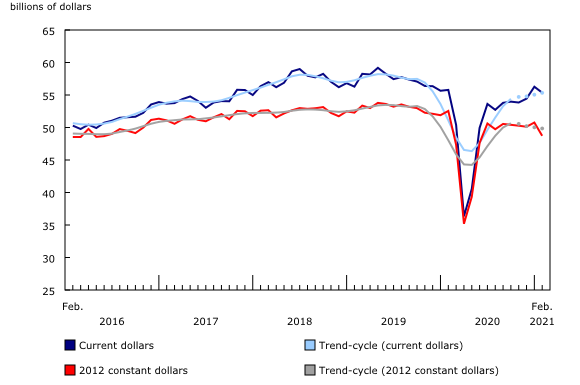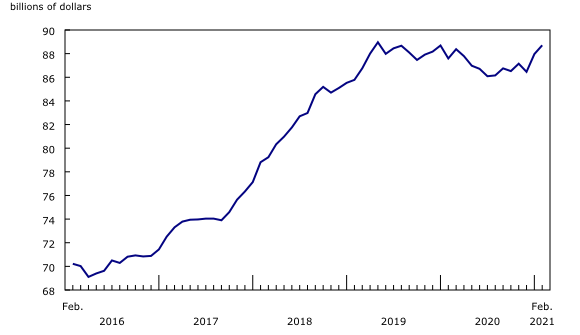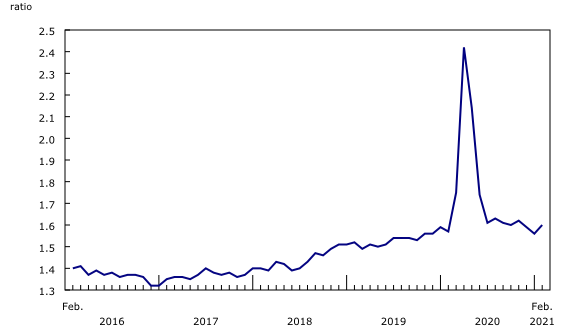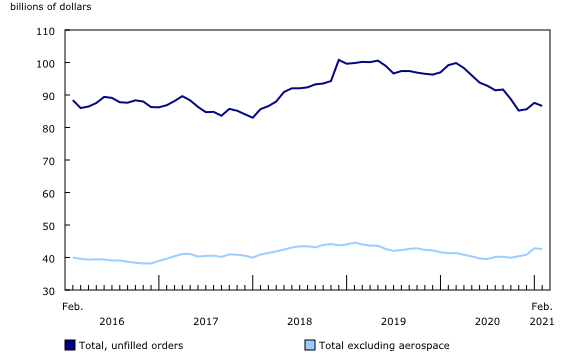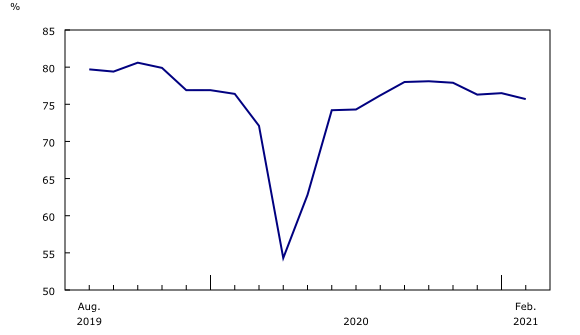Monthly Survey of Manufacturing, February 2021
Archived Content
Information identified as archived is provided for reference, research or recordkeeping purposes. It is not subject to the Government of Canada Web Standards and has not been altered or updated since it was archived. Please "contact us" to request a format other than those available.
Released: 2021-04-15
Following the largest increase observed in seven months in January (+3.4%), manufacturing sales fell 1.6% to $55.4 billion in February on lower sales of transportation equipment. The declines were partially offset by higher sales in the petroleum and coal product, chemical, and wood product industries.
Since January, motor vehicle and motor vehicle parts manufacturers have faced a semiconductor shortage, which has led to production slowdowns or shutdowns at several auto assembly plants. The tight supply of semiconductors also impacted plastics and rubber products manufacturing in February as a result of lower demand for plastic products from the auto industry. These declines brought total manufacturing sales down 0.8% year over year in February.
In constant dollars, manufacturing sales decreased 4.0%, indicating that higher prices mitigated a significantly lower volume of goods sold in February. The gains in the Industrial Product Price Index in February were widespread, rising 9.8% for energy and petroleum products, 5.2% for lumber and other wood products, and 3.9% for chemicals and chemical products.
Semiconductor shortage continues to stall auto production
Following a 9.1% decrease in January, motor vehicle sales fell 14.5% to $3.3 billion in February, their lowest level since May 2020, because of the global shortage of microchips. Some assembly plants ramped down production or extended shutdowns in February as a result. Year over year, sales of motor vehicles were down by almost one-third (-31.2%). Exports of motor vehicles and parts decreased 10.2% in February.
The semiconductor supply issue also stalled production of motor vehicle parts, leading to a 10.9% decline in sales to $2.2 billion in February, their lowest level since May 2020.
Sales of plastics and rubber products decreased 8.7% to $2.7 billion in February, driven by lower plastic product sales. Lower demand from motor vehicle and motor vehicle parts manufacturers partially contributed to the sales decline in February.
The non-metallic mineral products (-15.8%) and aerospace product and parts (-15.8%) industries also contributed to lower sales in February.
Sales in the petroleum and coal product industry rose 6.5% to $4.7 billion in February, their fifth consecutive gain and their highest level since February 2020. Higher prices were entirely responsible for the gain as sales volumes were down 3.3% in February. Petroleum production declined in the United States because of an extreme cold snap in mid-February. This, along with increased global demand, contributed to higher prices. Exports of refined petroleum energy products rose 27.2% in February.
Chemical sales rose 3.8% to $4.7 billion in February on higher sales of basic chemicals, followed by soap, cleaning compound and toilet preparation products. Sales of chemicals in February were at their highest level since November 2018. During the COVID-19 pandemic, sales in the chemical industry decreased 8.0% in April 2020 and then rose slowly on higher sales of basic chemicals, followed by resin and synthetic rubber products, as well as pesticides and other agricultural chemicals.
Wood product sales rose for the third consecutive month, up 4.0% to $4.3 billion in February on higher prices and volumes. Prices for lumber and other wood products increased 5.2% in February, while the volume of goods sold edged up 0.2%. The total value of building permits issued rose 2.1% in February and passed $10 billion for the first time on the continued strength of the housing market.
Sales also increased in the primary metal industry (+2.5%) and in printing and related support activities (+12.9%).
Semiconductor shortage hits Ontario the hardest
Manufacturing sales fell in four provinces in February, led by Ontario and New Brunswick. Quebec reported the largest sales increase.
Following a 3.7% increase in January, sales in Ontario declined 5.3% to $24.3 billion in February, mainly on lower sales of motor vehicles (-15.0%) and motor vehicle parts (-11.6%). Some motor vehicle and motor vehicle parts manufacturers had to operate at a lower production capacity rate in February in response to the semiconductor shortage. Sales of plastics and rubber products declined 15.3% in February on lower demand from the auto sector. These declines were partially offset by higher sales in the chemical (+2.7%), primary metal (+3.5%), and petroleum and coal product (+4.6%) industries. Overall, manufacturing sector sales in Ontario were down 6.8% year over year in February.
In New Brunswick, sales declined 4.8% to $1.5 billion in February, following five consecutive monthly gains, driven by lower sales in non-durable goods industries (-6.9%). Despite the decline in February, sales in New Brunswick were up 10.1% year over year.
Sales in Quebec increased for the fourth consecutive month, rising 1.8% to $14.1 billion in February, their highest level since October 2019. Higher sales in the wood product (+11.2%), chemical (+11.4%), and petroleum and coal product (+6.2%) industries contributed the most to the increase.
Sales in Alberta rose 1.9% to $6.1 billion in February on higher sales in the petroleum and coal product (+7.7%), food (+5.0%), and chemical (+3.5%) industries. Excluding October 2020, sales in the petroleum and coal industry in Alberta have been rising since May 2020; however, year over year, total manufacturing sales in Alberta were down 2.3%.
Sales decline in Regina and Winnipeg, rise in Toronto
Manufacturing sales on an unadjusted basis were down in 7 of the 12 census metropolitan areas (CMAs) covered by the survey in February, led by Regina and Winnipeg. Toronto posted the largest increase.
Following a 119.2% gain in January, sales in Regina decreased 17.2% in February on lower sales of pesticide, fertilizer and other agricultural chemicals. This industry was the main contributor to the large gain in January.
Sales in Winnipeg fell 11.7% to $764.0 million in February, their lowest level since April 2020, on lower sales in the transportation equipment industry. Manufacturing sector sales were down 7.6% on a year-over-year basis.
Manufacturing sales in Toronto rose 4.3% in February, mitigating some of the 13.4% decrease in January. While sales of motor vehicles declined in Ontario in February, sales rose (+81.4%) for two assembly plants in the Toronto CMA after significant production disruptions in January because of the semiconductor chip shortage. These gains were partially offset by lower sales of food (-5.0%), aerospace products and parts (-15.1%), and fabricated metal products (-3.8%). Year over year, manufacturing sector sales in Toronto decreased 10.9%.
Inventory levels rise
Total inventories rose 0.8% to $88.7 billion in February, their highest level since May 2019, on higher inventories of beverages and tobacco products (+14.4%), primary metals (+3.2%), and petroleum and coal products (+4.8%). Inventories fell in the aerospace product and parts (-6.1%), furniture and related product (-9.9%), and plastics and rubber products (-1.8%) industries.
The inventory-to-sales ratio increased from 1.56 in January to 1.60 in February. This ratio measures the time, in months, that would be required to exhaust inventories if sales were to remain at their current level.
Unfilled orders decline
Following two consecutive monthly gains, unfilled orders decreased 1.1% to $86.6 billion in February, on lower unfilled orders of transportation equipment (-1.9%) and chemicals (-6.8%). Unfilled orders were up in the primary metal (+9.6%), miscellaneous manufacturing (+8.4%) and wood product (+11.3%) industries.
The total value of new orders fell 6.6% to $54.4 billion in February, driven by lower unfilled orders of transportation equipment (-33.0%). The declines were partially offset by higher new orders in the wood product, petroleum and coal product, and primary metal industries.
Capacity utilization rate declines
The capacity utilization rate (not seasonally adjusted) for the total manufacturing sector fell from 76.5% in January to 75.7% in February, attributable to lower production.
Capacity utilization rates decreased in the transportation equipment (-1.3 percentage points), plastics and rubber products (-1.8 percentage points), and non-metallic mineral product (-4.0 percentage points) industries. The capacity utilization rate rose in the wood product (+1.4 percentage points) and primary metal (+0.6 percentage points) industries.
Sustainable development goals
On January 1, 2016, the world officially began implementing the 2030 Agenda for Sustainable Development—the United Nations' transformative plan of action that addresses urgent global challenges over the following 15 years. The plan is based on 17 specific sustainable development goals.
The Monthly Survey of Manufacturing is an example of how Statistics Canada supports the reporting on the global sustainable development goals. This release will be used to help measure the following goal:

Note to readers
Monthly data in this release are seasonally adjusted and are expressed in current dollars unless otherwise specified.
Seasonally adjusted data are data that have been modified to eliminate the effect of seasonal and calendar influences to allow for more meaningful comparisons of economic conditions from period to period. For more information on seasonal adjustment, see Seasonally adjusted data – Frequently asked questions.
Trend-cycle estimates are included in selected charts as a complement to the seasonally adjusted series. These data represent a smoothed version of the seasonally adjusted time series and provide information on longer-term movements, including changes in direction underlying the series. For information on trend-cycle data, see Trend-cycle estimates – Frequently asked questions.
Both seasonally adjusted data and trend-cycle estimates are subject to revision as additional observations become available. These revisions could be large and could even lead to a reversal of movement, especially for reference months near the end of the series or during periods of economic disruption.
Non-durable goods industries include food, beverage and tobacco products, textile mills, textile product mills, clothing, leather and allied products, paper, printing and related support activities, petroleum and coal products, chemicals, and plastics and rubber products.
Durable goods industries include wood products; non-metallic mineral products; primary metals; fabricated metal products; machinery; computer and electronic products; electrical equipment, appliances and components; transportation equipment; furniture and related products; and miscellaneous manufacturing.
Production-based industries
For the aerospace and shipbuilding industries, the value of production is used instead of the value of sales of goods manufactured. The value of production is calculated by adjusting monthly sales of goods manufactured by the monthly change in inventories of goods in process and finished products manufactured. The value of production is used because of the extended period of time that it normally takes to manufacture products in these industries.
Unfilled orders are a stock of orders that will contribute to future sales, assuming that the orders are not cancelled.
New orders are those received, whether sold in the current month or not. New orders are measured as the sum of sales for the current month plus the change in unfilled orders from the previous month to the current month.
Manufacturers reporting sales, inventories and unfilled orders in US dollars
Some Canadian manufacturers report sales, inventories and unfilled orders in US dollars. These data are then converted to Canadian dollars as part of the data production cycle.
For sales, based on the assumption that they occur throughout the month, the average monthly exchange rate for the reference month established by the Bank of Canada is used for the conversion. The monthly average exchange rate is available in table 33-10-0163-01. Inventories and unfilled orders are reported at the end of the reference period. For most respondents, the daily average exchange rate on the last working day of the month is used for the conversion of these variables.
However, some manufacturers choose to report their data as of a day other than the last day of the month. In these instances, the daily average exchange rate on the day selected by the respondent is used. Note that because of exchange rate fluctuations, the daily average exchange rate on the day selected by the respondent can differ from both the exchange rate on the last working day of the month and the monthly average exchange rate. Daily average exchange rate data are available in table 33-10-0036-01.
Revision policy
Each month, the Monthly Survey of Manufacturing releases preliminary data for the reference month and revised data for the three previous months. Revisions are made to reflect new information provided by respondents and updates to administrative data.
Once a year, a revision project is undertaken to revise multiple years of data.
Real-time data tables
Real-time data tables 16-10-0118-01, 16-10-0119-01, 16-10-0014-01 and 16-10-0015-01 will be updated on April 22.
Next release
Data from the Monthly Survey of Manufacturing for March will be released on May 14.
Contact information
For more information, or to enquire about the concepts, methods or data quality of this release, contact us (toll-free 1-800-263-1136; 514-283-8300; STATCAN.infostats-infostats.STATCAN@canada.ca) or Media Relations (613-951-4636; STATCAN.mediahotline-ligneinfomedias.STATCAN@canada.ca).
- Date modified:




